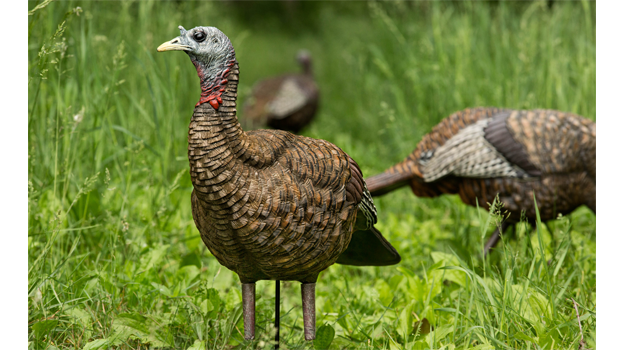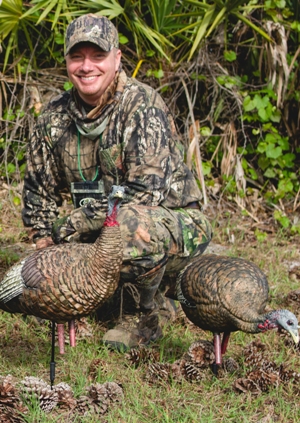
Editor’s Note: Matt Morrett represents Zink Wild Game Calls, Avian X decoys and the Plano Company. He has been a Mossy Oak Pro most of his life. After winning his first World Turkey Calling Championship when he was 16-years old, he has stacked-up turkey calling championships higher than he is tall. During turkey season, he probably sleeps in Mossy Oak camo, so he can jump out of the bed before first light and get out into the turkey woods. We've asked Matt this week to tell us how he deals with some of the worst turkey-hunting problems.
In the last 10 years, more and more people have tried to hunt field turkeys. The reason there has been an increase in hunters trying to take gobblers out in the field is they’re:
- easy to see from a long distance;
- often strutting in the field; and
- relatively easy to get close to without the hunter being seen.
On most fields, the edges of the fields are wooded. Finding a gobbler out in the field is the easiest way to locate a turkey to hunt. However, a field turkey oftentimes is one of the most-difficult turkeys to hunt. A really-smart field turkey will fly down from the roost, land out in the middle of the field, strut, drum and call his hens to him. He’ll stay out in the field until the sun gets so high and hot that he has to move out of the field and into the shade - usually the time that many hunters have left the woods.
The big advantage that the field turkey has is that he can see danger coming for 360 degrees. When he struts, hens quickly and easily can see him and come out into the field to meet him. Usually, bugs and young tender grass are out in the field for him to eat. Turkeys also like to go out in fields on rainy and cloudy days. On rainy days, they can dry their feathers quicker in the field than in the woods. Because of the rain and the wind, on a rainy day, they can’t hear as well in the woods as they can out in the fields. They can see predators better in the field than they can in the woods, and the fields make slipping up on a turkey much-more difficult for a predator than hiding under a bush or a tree.
Another advantage that the field turkey has is that when he hears a hen calling to him from the woods, he knows that hen should be able to hear him and see him out in the middle of the field. Therefore, she should come to him. If the hen that’s calling from the woods doesn’t come out in the field to the gobbler, the gobbler says, “There is something strange about this hen. If she doesn’t come out into the field where I can see her, I'm not going to her.”
 Field turkeys may be one of the toughest turkeys to call within gun range. So, the turkey hunter now has to develop methods to increase his odds for getting that field turkey to come over to the edge of the field where he's hiding and can get a shot. One of the best ways to get that turkey within gun range is go to the field when the field is black dark - before daylight - and put out your turkey decoys. I’ll most often use an Avian X jake decoy and a hen decoy - either a feeding hen, a breeding hen or a lookout hen decoy. By putting out two decoys, you want to present the illusion that a hen on the edge of the field may be ready to breed, and a juvenile gobbler is there looking for the opportunity to breed that hen. So, by using these two decoys and putting them on the field edge before the gobbler flies down to the field, then when the gobbler gets out into the field, he has two reasons to come over to the edge of the field where you can take a shot. More than likely, when a gobbler spots those two decoys and starts walking to them, he’ll walk toward the jake decoy before he walks to the hen decoy.
Field turkeys may be one of the toughest turkeys to call within gun range. So, the turkey hunter now has to develop methods to increase his odds for getting that field turkey to come over to the edge of the field where he's hiding and can get a shot. One of the best ways to get that turkey within gun range is go to the field when the field is black dark - before daylight - and put out your turkey decoys. I’ll most often use an Avian X jake decoy and a hen decoy - either a feeding hen, a breeding hen or a lookout hen decoy. By putting out two decoys, you want to present the illusion that a hen on the edge of the field may be ready to breed, and a juvenile gobbler is there looking for the opportunity to breed that hen. So, by using these two decoys and putting them on the field edge before the gobbler flies down to the field, then when the gobbler gets out into the field, he has two reasons to come over to the edge of the field where you can take a shot. More than likely, when a gobbler spots those two decoys and starts walking to them, he’ll walk toward the jake decoy before he walks to the hen decoy.
If you don’t have any decoys, and you find a gobbler in the field, start calling to him and hear him gobble back, then you have to employ the most-difficult aspect of turkey hunting - patience. More than likely, that gobbler won’t come strutting to you. He may follow his hens out of the field. He may hear another turkey gobbling. He may leave the field and go to that other gobbler, but he hasn’t forgotten where you are. At some point during the day, especially after his hens have left him, he may come back to that field or move through the woods to try and find you. This is when you can take him. So, don’t give-up on those field turkeys.
Day 2: Matt Morrett Loves to Use Friction Calls for Gobblers
Tomorrow: A Turkey Decoy May Work, But Perhaps Not




























